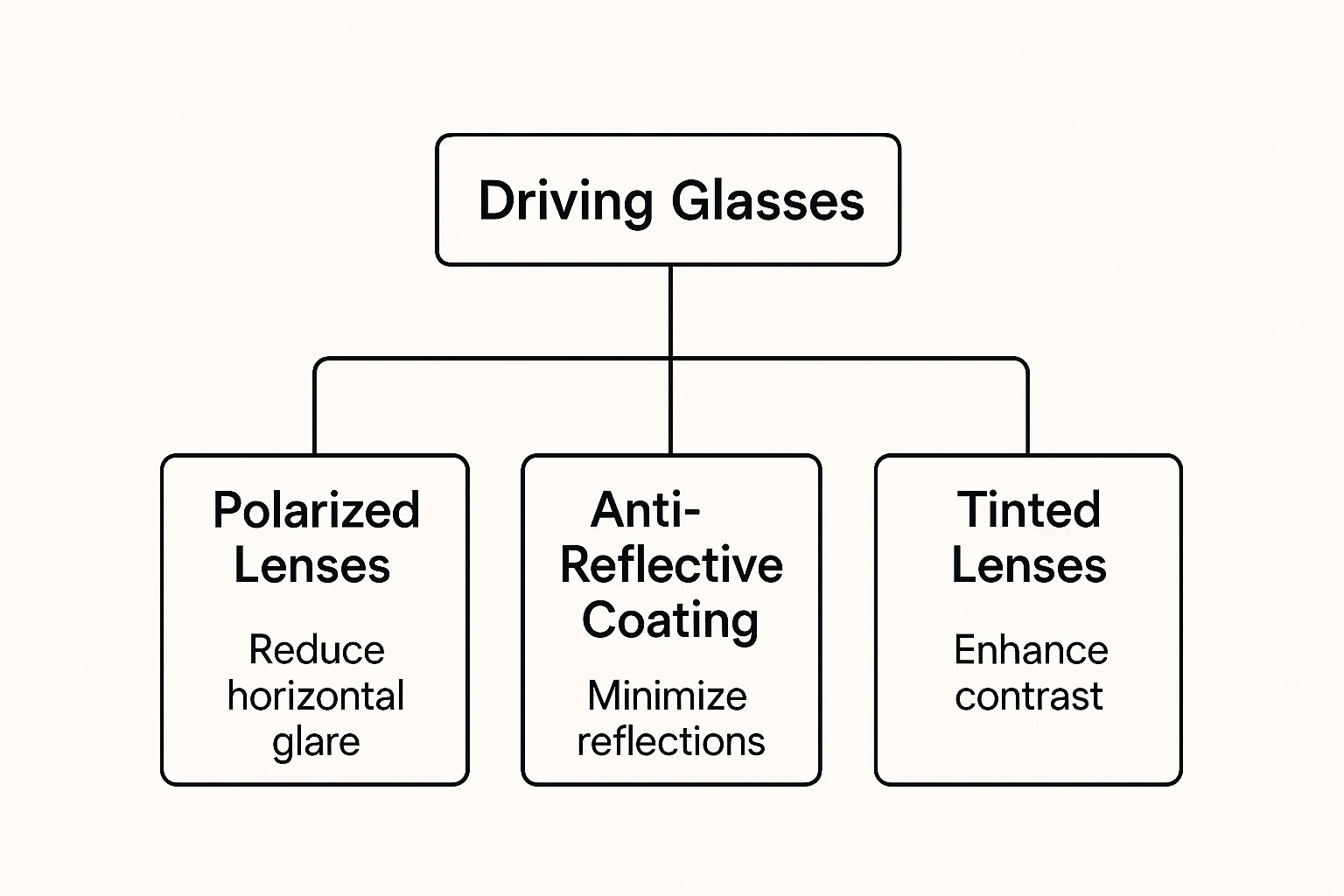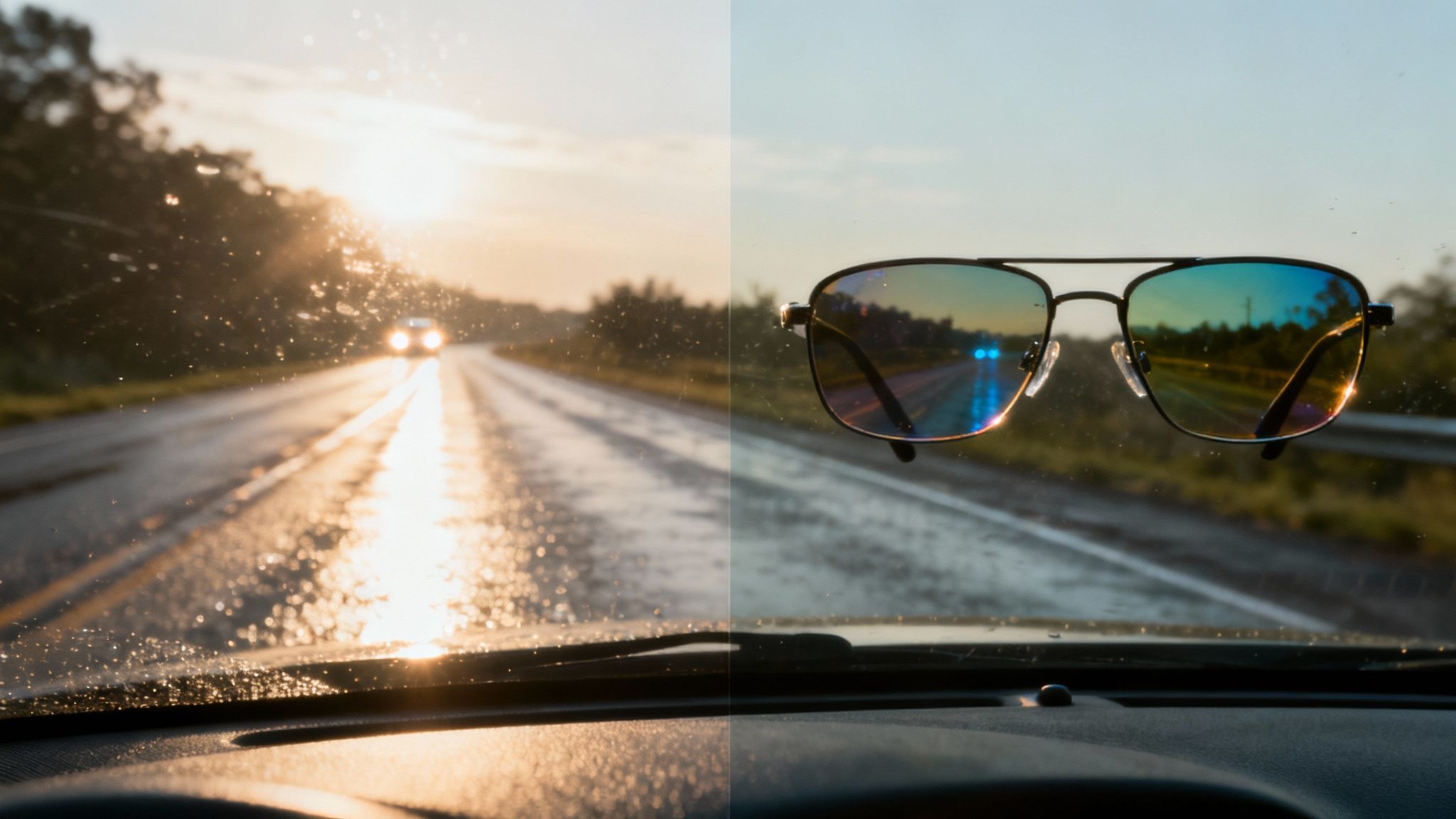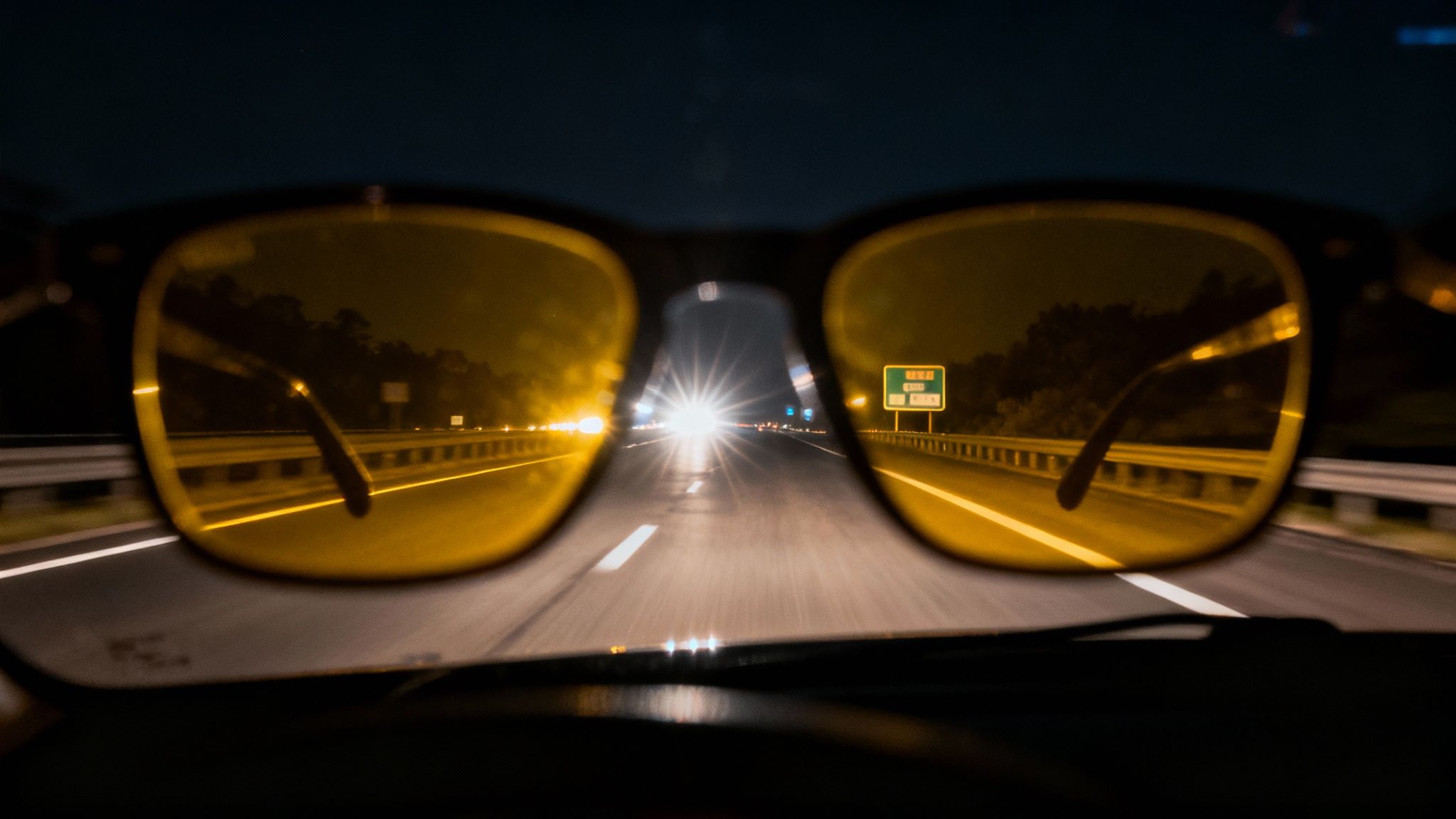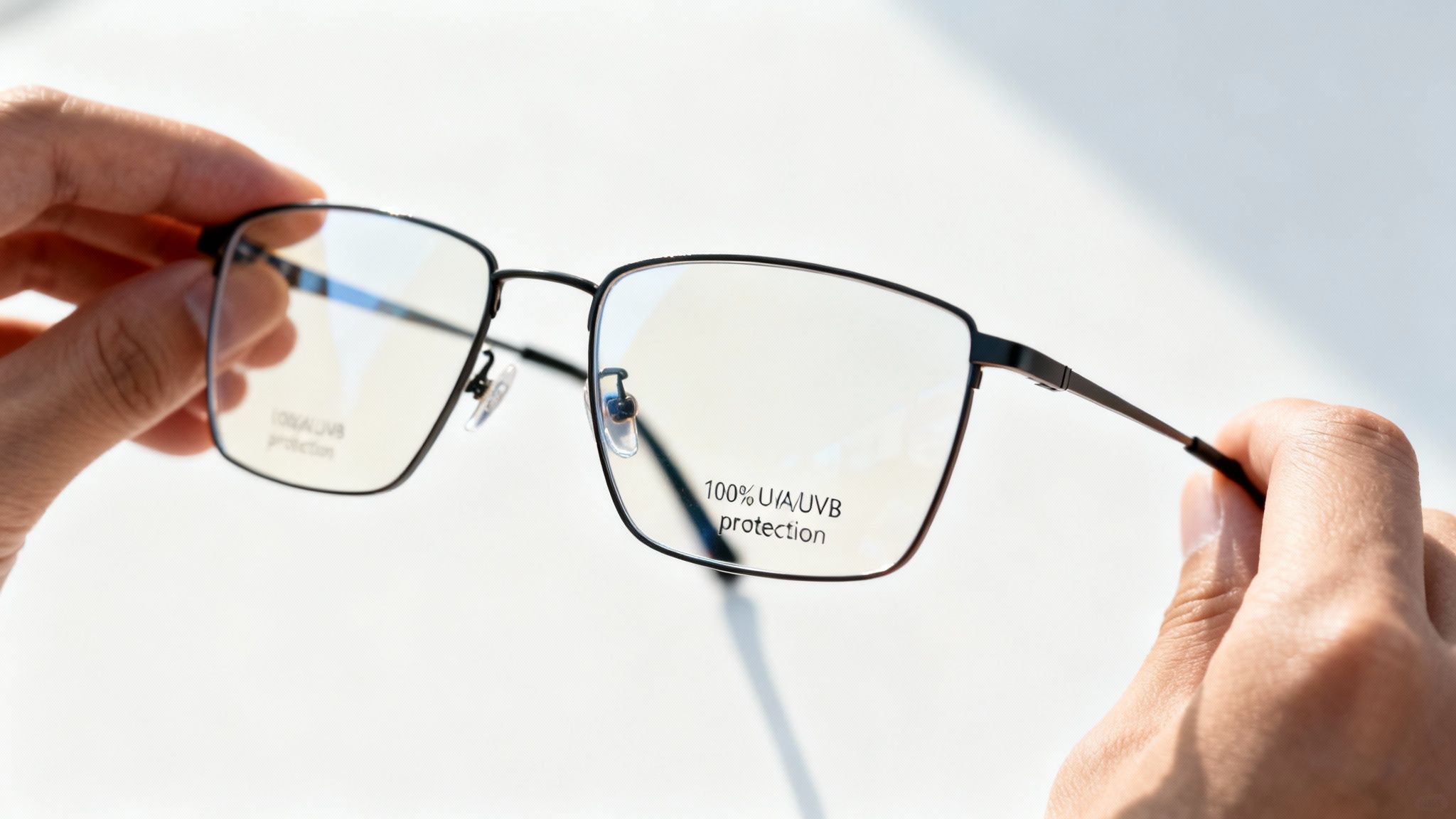
What Are Driving Glasses and How Do They Work
So, what exactly are driving glasses? It's easy to mistake them for regular sunglasses, but they're a completely different piece of kit. Think of them as specialized eyewear engineered from the ground up to make your time behind the wheel safer and more comfortable.
These glasses feature advanced lens technologies built specifically to cut glare, boost contrast, and give you a clearer view of the road, whether you're driving in the blinding sun, on a gray, overcast day, or even at night.
What Are Driving Glasses Used For?
Imagine driving glasses as a high-definition filter for your eyes, custom-built to tackle the unique visual challenges you face on the road. While your everyday sunglasses just make things darker, driving glasses actively work to sharpen your vision. This helps you spot potential hazards, read road signs from a distance, and see other cars more clearly.
Their main job is to fight the visual interference caused by the environment, especially glare. Glare is just scattered, unfocused light that washes everything out and can be incredibly dangerous. It pops up from all sorts of places:
- Direct sunlight, which is particularly bad during sunrise and sunset when the sun is low on the horizon.
- Reflections bouncing off wet roads, snow, or even the hoods of other vehicles.
- Oncoming headlights during night drives.
By taming this intense, distracting light, driving glasses mean you don't have to squint. This dramatically cuts down on eye strain and fatigue, especially on longer trips, helping you stay alert and focused on driving safely.
A Quick Guide to Driving Lens Types
To get a better handle on which type of glasses might be right for you, it helps to understand the main lens options available. Each one is designed for different situations you'll encounter on the road.
This table breaks down the most common types to give you a quick comparison.
| Lens Type | Primary Benefit | Best For |
|---|---|---|
| Polarized | Eliminates harsh glare from reflective surfaces | Bright, sunny days; driving near water or snow |
| Anti-Reflective | Reduces internal reflections and halos | Night driving; reducing glare from headlights |
| Tinted | Enhances contrast and depth perception | Overcast days, fog, low-light conditions |
| Photochromic | Adapts to changing light conditions | All-around driving; transitioning from light to dark |
Choosing the right lens really comes down to when and where you do most of your driving. Many high-quality driving glasses will actually combine these technologies for the best possible performance.
Key Technologies in Driving Lenses
The real magic behind these glasses lies in a few core technologies that work in tandem to improve your vision. This diagram shows how each piece of the puzzle plays a critical role.

As the infographic highlights, it's the combination of polarization, anti-reflective coatings, and specific lens tints that make driving glasses so effective. Each feature is designed to solve a particular problem—from blinding glare to poor contrast—all working together to create a safer, less stressful driving experience.
How Driving Lenses Tame Dangerous Glare
You know that feeling—that split second when you’re completely blinded by the sun reflecting off a wet road or the hood of the car in front of you? That intense, startling flash is called horizontal glare, and it’s the exact reason driving glasses are such a game-changer for road safety. These aren't just sunglasses; they are specialized lenses engineered to manage light and bring clarity back to your vision.

The number one weapon against this kind of glare is polarization. The easiest way to picture a polarized lens is to think of it as a microscopic set of Venetian blinds. This filter is aligned vertically, which means it lets the safe, vertical light pass through to your eyes while completely blocking the harsh, horizontal light that causes glare. The result is a much crisper, clearer view, all without squinting.
More Than Just Polarization
But great driving glasses don't stop there. Beyond tackling direct glare, they address other frustrating light-related issues. Another critical feature is an anti-reflective (AR) coating. This thin layer is applied to both sides of the lens to cut down on those distracting reflections from oncoming headlights, streetlights, and even the lights on your own dashboard.
Think of an AR coating as a quiet sponge for light. It absorbs those secondary reflections, stopping them from creating the annoying halos or starbursts that can mess with your vision, particularly at night. If you want to dive deeper into how this works, you can learn more about the benefits of an anti-glare coating on glasses.
It's no surprise this kind of technology is gaining traction. As more people focus on driving safety, the global driver glasses market is expected to grow at a compound annual growth rate (CAGR) of 10.90% from 2023 to 2030. That shows a real demand for eyewear that enhances vision on the road.
Key Takeaway: The one-two punch of polarization and anti-reflective coatings doesn't just make driving more comfortable. It actively gets rid of visual distractions, helping you spot hazards more clearly and react that much faster.
The Role of Lens Tints
Finally, the color of the lens itself plays a huge part. Specific lens tints, like amber or yellow, are deliberately chosen for their ability to filter out certain wavelengths of light—especially the blue light that can create a sense of visual haze.
By filtering out this hazy light, tinted lenses give your contrast a serious boost and improve your depth perception. This makes it far easier to pick out objects from their background, whether you're trying to see a pothole on a gray, overcast day or make out the edges of the road in the fog.
The Real-World Benefits of Driving Glasses
So, beyond all the talk about lens technology and glare, what do driving glasses actually do for you when you're behind the wheel? The benefits are very real, affecting both your safety and your comfort on every single trip. They genuinely change how you experience the road.
One of the first things you'll notice is a huge reduction in eye strain. When you stop squinting against harsh sunlight, slick road reflections, or oncoming high-beams, your eye muscles finally get a chance to relax. This simple change drastically lowers physical eye fatigue and the mental drain that comes with it, keeping you far more alert and focused, especially on longer journeys.
Gaining a Critical Safety Edge
At its core, the main benefit of driving glasses is enhanced safety. By cutting down on blinding glare, you gain precious milliseconds of reaction time—the kind of time that can make all the difference in avoiding an accident.
Think about these common, real-world situations:
- Driving into a Sunset: Instead of being completely blinded, you can see the road, the lane markings, and the cars ahead of you clearly.
- Facing Nighttime Headlights: Those distracting halos and starbursts from oncoming traffic are dramatically reduced, letting you focus on your own lane without feeling disoriented.
- Wet Roads After Rain: Dangerous, mirror-like reflections are neutralized, making it much easier to spot potholes, debris, or other hazards.
By improving your visual clarity, driving glasses give you the power to spot road signs, pedestrians, and other hazards with more confidence and speed.
Ultimately, this all adds up to a less stressful and much safer drive. Of course, while driving glasses are a massive boost for your perception, total road safety depends on your whole vehicle. For instance, it's always smart to review correct tire pressure tips for safer driving to make sure your car is as ready as your eyes are. Clear vision paired with a well-maintained vehicle is a powerful combination for staying safe out there.
Understanding Night Driving Glasses
Driving after dark brings a whole new set of visual challenges. From the blinding glare of modern LED headlights to the general drop in visibility, your eyes are working overtime. This is exactly where night driving glasses come into play.
You’ll recognize them by their distinct yellow or amber-tinted lenses, which are engineered specifically to tackle these tricky low-light conditions.

Their main job is to filter out a slice of the harsh, high-energy blue light that floods our vision at night. This is the exact type of light that causes those distracting starbursts and halos around streetlights and oncoming cars, making it tough to focus. By cutting down on that specific light, these glasses help reduce that disorienting glare.
More and more drivers are catching on. In 2023, the global market for night driving glasses hit USD 4.2 billion and is expected to nearly double to USD 8.1 billion by 2032. This isn't just a random trend; it shows a real demand for anything that can make driving in low light safer, especially for those of us who find nighttime glare particularly bothersome. You can see more on the night driving glasses market trends on dataintelo.com.
How They Actually Improve Your Vision
Let's clear up a common myth: night driving glasses don't magically make the dark brighter. They can't amplify light that isn't there. Their real power is in improving the quality of the light your eyes are already receiving.
By cutting through the visual "noise" of blue light, the yellow or amber tint enhances contrast and sharpens your depth perception. This makes it easier to distinguish objects, spot the edges of the road, and judge distances more accurately.
Think of it like adjusting the contrast on your TV. The screen doesn’t get any brighter, but the details suddenly pop, becoming much sharper and clearer. That’s what these glasses do for your vision on the road.
This specialized focus is what makes them such an invaluable tool for anyone looking to make their nighttime drives safer and far more comfortable. For a deeper dive, you can explore our complete guide to night driving glasses.
How to Choose the Right Driving Glasses
Ready to find the perfect pair of driving glasses? It's about a lot more than just looks; the right choice comes down to safety, clarity, and comfort for your time behind the wheel. From the lens material to the way the frame sits on your face, every little detail counts.

When you start your search, the lenses are ground zero. Polycarbonate lenses are a fantastic option. They’re incredibly tough against impacts—giving you an extra layer of protection—and they’re super lightweight. Another non-negotiable is 100% UVA and UVB protection. Those harmful UV rays are just as sneaky on cloudy days as they are when the sun is beaming down.
Key Features to Look For
Beyond the basics, the actual design of the glasses can make a huge difference in your driving experience. The frames, for instance, can be a real problem if they're too bulky, creating dangerous blind spots where you least expect them.
- Thin Temples: Pay close attention to the arms of the glasses (the temples). You want a pair with thin temples that won't block your peripheral vision. This is crucial for spotting traffic or pedestrians coming from the side.
- Comfortable Fit: A snug but comfortable fit is essential. The glasses need to stay put on your nose and ears without sliding down, especially on longer trips.
- Lightweight Materials: Heavy frames can create annoying pressure points and become a real distraction. Lightweight materials help you forget you’re even wearing glasses.
The best driving glasses are the ones you barely notice. They should enhance your vision without creating distractions of their own.
Deciding on Lens Technology
You’ll also have to pick between different lens technologies, and the right choice really depends on your driving habits. Polarization is a game-changer for daytime driving, cutting through harsh glare. On the other hand, photochromic lenses, which automatically darken in sunlight and lighten indoors, offer incredible versatility. Understanding the pros and cons is key, and you can explore various lens options for glasses in our detailed guide.
Taking care of your eyes is a 24/7 job. Just as driving glasses shield your vision on the road, it's just as important to protect them from digital screens once you're done driving. That's where blue light glasses come in, and for that, we highly recommend PROSPEK glasses. They offer a great way to reduce digital eye strain. It’s no surprise the broader eyewear market, which includes all these specialized glasses, is growing so quickly. Valued at USD 200.46 billion in 2024, it’s expected to reach USD 335.90 billion by 2030 as more of us prioritize vision correction and protection. You can explore more about these eyewear market trends to see how the industry is evolving.
Answering Your Questions About Driving Glasses
As we wrap up, a few practical questions always seem to pop up. Let's tackle some of the most common points of confusion to help you figure out if a dedicated pair of driving glasses makes sense for you.
Can I Use Polarized Glasses for Night Driving?
This is a big one, and the answer is an emphatic no. It's a critical safety issue. Polarized lenses are brilliant during the day because their main job is to block a significant amount of light to kill that blinding glare.
At night, though, that light-blocking feature becomes a serious hazard. It can dramatically reduce what you're able to see in dark conditions, making it harder to spot cyclists, pedestrians, or debris on the road. For nighttime, you want non-polarized lenses, ideally with an anti-reflective coating to manage the glare from oncoming headlights.
Are Yellow-Tinted Glasses Actually Better for Night Driving?
You’ll find plenty of drivers who won't drive at night without them, and they have a point. Lenses with a yellow or amber tint are great at filtering out the specific part of the blue light spectrum that causes that distracting, fuzzy glare from streetlights and headlights.
They won’t magically turn night into day, but they can make a real difference in contrast, helping the visual information you do see feel sharper and more defined. While everyone's experience is a bit different, many find they help cut down on those disorienting halos around bright lights.
What Is the Difference Between Driving Glasses and Regular Sunglasses?
It's a fair question. While some high-quality sunglasses can certainly be used for driving, a pair of specialized driving glasses is engineered from the ground up for performance behind the wheel.
They usually have superior polarization to wipe out road glare, anti-reflective coatings to stop annoying reflections from your dashboard, and lightweight frames with thin arms that don’t get in the way of your crucial peripheral vision. Many fashion sunglasses, in contrast, might be too dark for driving in changing light conditions or simply won't have these key safety features built in.
Do I Need a Prescription for Driving Glasses?
Not always. If your vision is fine without correction, you can easily find non-prescription driving glasses (often called 'plano' lenses) that offer all the glare-reducing benefits.
However, if you already depend on glasses to see clearly, you absolutely can and should get driving lenses made with your specific prescription. There's no reason to compromise on clarity when you can have the best of both worlds.
Your eyes put in a lot of work, both behind the wheel and in front of a screen. To give them a break from digital eye strain after a long drive, we recommend the excellent blue light glasses from PROSPEK. You can explore our entire collection of performance eyewear at https://www.spektrumglasses.com.
